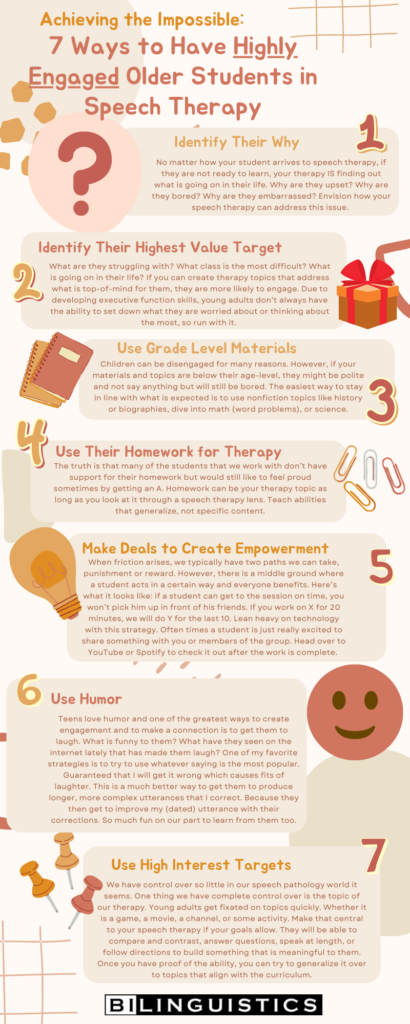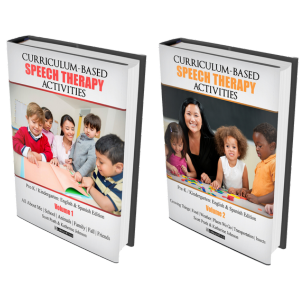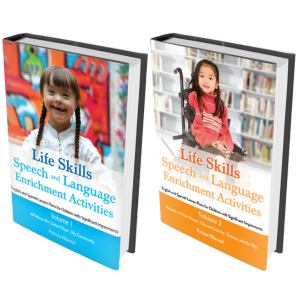I have to admit, I LOVE working in elementary schools. This became crystal clear to me when I was offered the chance to do testing and cover a maternity leave at a middle and high school. You’ve seen the front office of elementary schools. Lots of smiles, primary colors, and jewelry that matches the season. The offices of the middle and high schools can be downright scary! On my first campus, a 5-foot tall door guard looked me up and down asking me what I was doing there. I began to stammer something about an evaluation as I fumbled for my badge and then was shuttled off to the corner to wait with a bunch of silent parents. Detention rooms! Kids as tall as you staring you down as you pass through the hall. Scary. At first, anyway. I now LOVE all grade levels. But it really only came about when I was able to create highly engaging speech therapy for older students so that I was having a great time with the kids and the teachers understood how I could help out.
Creating the best speech therapy for older students is dependent on making a connection, gaining trust, and finding out how the time together can be valuable to them.
This essay is a collective of intervention strategies from my experience and the many great SLPs I have partnered with at the older grade levels. Being bilingual and doing evals has allowed me to skate around to many of these campuses and lean on the select few among us who brave the world of teenagers. For those of you at the elementary level, these tips are golden for the 3rd to 5th graders who have bought a one-way ticket to the land of snarky.
Check these out and then I have a beautiful infographic for you to download at the bottom, as well as a way to learn more.
7 Ways to Achieve the Impossible: Highly Engaged Speech Therapy for Older Students
We need to start by talking about some of the things that we are up against that make engaging older students so difficult. Older students:
- Have been in speech for a while and are tired of it, maybe a bit defeated.
- Are often embarrassed to come.
- Have multiple teachers so they are difficult to track down.
- Have multiple teachers so it is difficult to tie what you are doing to the curriculum.
- Are more self-conscious about being corrected.
- May not connect what you are doing to what they care about.
Juxtapose this against the willing smiling elementary school kids that skip down the hall holding your hand and you see what we are up against. All of this is to say is that the secret lies in finding the connection between what you are doing and what is most present on their mind or what they are worried about.
1. Identify Their Why
No matter how your student arrives to speech therapy, if they are not ready to learn, your therapy IS finding out what is going on in their life. Why are they upset? Why are they bored? Why are they embarrassed? Envision how your speech therapy can address this issue.
If we can get to the essence of what they’re avoiding or trying to laugh off, that’s going to be your ‘in” for what to focus on. If they are upset, it might be just because you picked them up, because they didn’t get their homework done, or perhaps they had a poor interaction with a teacher. Helping to resolve this in the session demonstrates your value and gains their buy-in for working.
2. Identify Their Highest Value Target
What are they struggling with? What class is the most difficult? What is going on in their life? If you can create therapy topics that address what is top-of-mind for them, they are more likely to engage. Due to developing executive function skills, young adults don’t always have the ability to set down what they are worried about or are thinking about the most, so run with it.
As an example, I was working with a voice student at a middle school who was super bright and had some the highest marks in math and science. The problem was that she hit an early growth spurt and her voice register dropped substantially so she stopped speaking and participating in class.
Her grades and science club were her highest value target so practicing her presentations became speech therapy. The topics you choose for your speech therapy for older students has to involve what they care about.

3. Use Grade Level Materials
Children can be disengaged for many reasons. However, if your materials and topics are below their age-level, they might be polite and not say anything but will still be bored. This gets difficult when you have older students whose developmental age doesn’t match their academic level. We still want to be on age or grade level, we just might not be able to use the same reading level or use complex concepts.
The easiest way to stay on top of what is expected academically is to use nonfiction topics like history or biographies or dive into math (word problems) or science. If you haven’t seen it yet, we did an entire one hour CEU course on choosing the best therapy materials for older students.
There is another advantage to using grade level materials because it demonstrates to the campus that we are supporting the teachers. With so many teachers all over a very large building, the easiest way to access the curriculum is to use the students’ homework.
4. Use Their Homework for Therapy
The truth is that many of the students that we work with don’t have support for their homework but would still like to feel proud sometimes by getting an A. Homework can be your therapy topic as long as you look at it through a speech therapy lens. Here’s what I mean: If you are teaching an ability that they can generalize to their next story, or next science project, you are doing a good job. If the child only learns about the topic (e.g., frogs), that’s a general education strategy.
If you want to get on target academically, overlap the classroom content, and prove to the student that you are there to help, have them dig into their backpacks and show you their homework.
Even if it’s an assignment that has been done before, what we’re suggesting is that you use the classroom content to give them the opportunity to raise their hand in class because they know the answer. Or, feel the pride from getting an A on something.
There’s a couple added benefits to this. Many of the students that we work with do not typically have one-on-one support. For instance, they might not have parents who speak English and can help with the homework. They might not have parents that are home in the evening because of work. They might be working on content that is above their parents’ educational level.
Secondly, with each student having 6-8 teachers on a campus with hundreds of students, it’s impossible to get a hold of them. Homework is your in. I know, I know, that’s not our job. And completing the homework is not our goal. But we can certainly work our therapy goals into the process.
5. Make Deals to Create Empowerment
When friction arises, we typically have two paths we can take, punishment or reward. However, there is a middle ground where a student acts in a certain way and everyone benefits.
The majority of older students in speech therapy only have 30 minutes/week. If they are goofing around throughout the session, showing up late, or going to the bathroom every session, they basically have next to ZERO speech therapy each month.
This was an epic fail on my part when I started at a high school. I went down to pick up a student, interrupted his class and made everyone stare at him and crack jokes as we walked out together. Do you think he was willing to come to or work in his speech sessions? Absolutely not. But it gave me an opportunity to make a deal to create empowerment where we both won. Here’s what it looks like:
If a student can get to the session on time, you won’t pick him up in front of his friends. If you work on X for 20 minutes, we will do Y for the last 10.
Lean heavily on technology with this strategy. Often times a student is just really excited to share something with you or members of the group. Head over to YouTube or Spotify to check it out after the work is complete.
The goal is to make the agreement result in a reward instead of a punishment. Teenagers can smell a punishment-based stand-off a mile away. And there is no greater way to avoid what you are doing than accept the challenge of doing what you are not supposed to!
6. Use Humor
Teens love humor and one of the greatest ways to create engagement and to make a connection is to get them to laugh. What is funny to them? What have they seen on the internet lately that has made them laugh?
One of my favorite strategies is to try to use whatever saying is the most popular. Guaranteed that I will get it wrong which causes fits of laughter. This is a much better way to get them to produce longer, more complex utterances that I correct. Because they then get to improve my (dated) utterance with their corrections. So much fun on our part to learn from them too.
On this note, we know that because older kids are in the midst of developing executive functioning skills they can struggle with temporal concepts. You can talk about the PAST weekend, PRESENT week, and FUTURE weekend and anything fun they have planned. This translates into when they are planning to get their homework done and cause-and-effect relationships in fiction and nonfiction.

7. Use High Interest Targets
We have control over so little in our speech pathology world it seems. One thing we have complete control over is the topic of our therapy. Young adults get fixated on topics quickly. Whether it is a game, a movie, a channel, or some activity. Make that central to your speech therapy if your goals allow. They will be able to compare and contrast, answer questions, speak at length, or follow directions to build something that is meaningful to them. Once you have proof of the ability, you can try to generalize it over to topics that align with the curriculum.

Want to Improve Your Speech Therapy with Older Students?
We created a CEU course about it.
Research-based Language Intervention for Older Students

Speech therapy with older students is a completely different ball game when it comes to therapy. We put together a one-hour conversation about how to hone or intervention skills at the higher grade levels.




